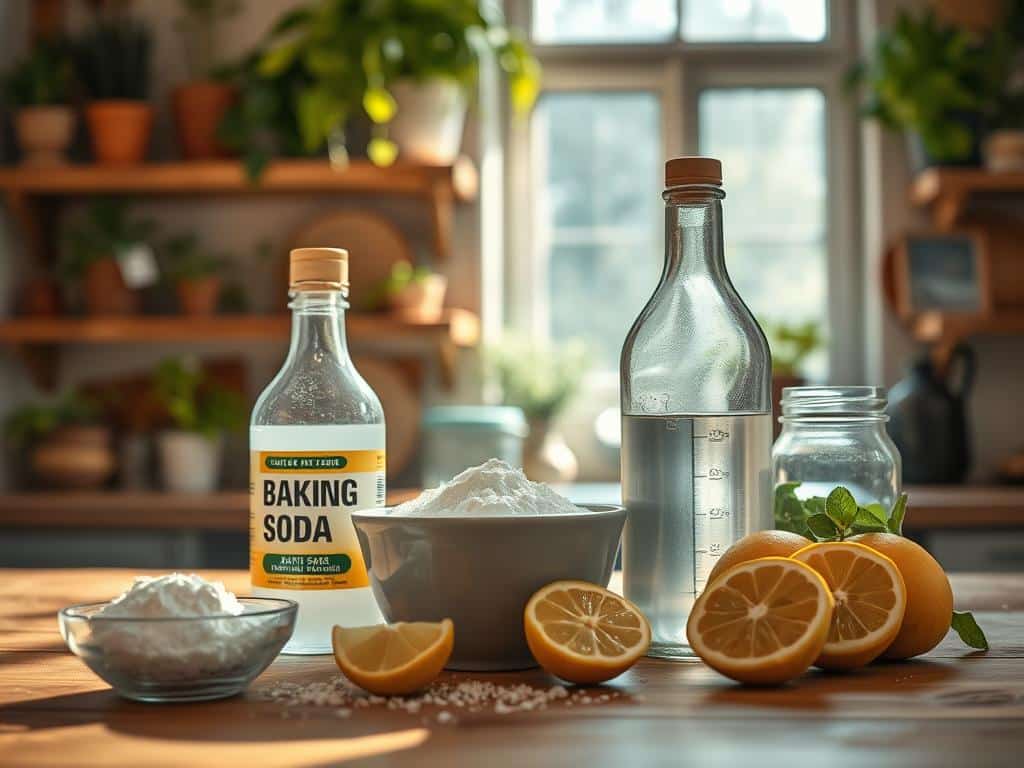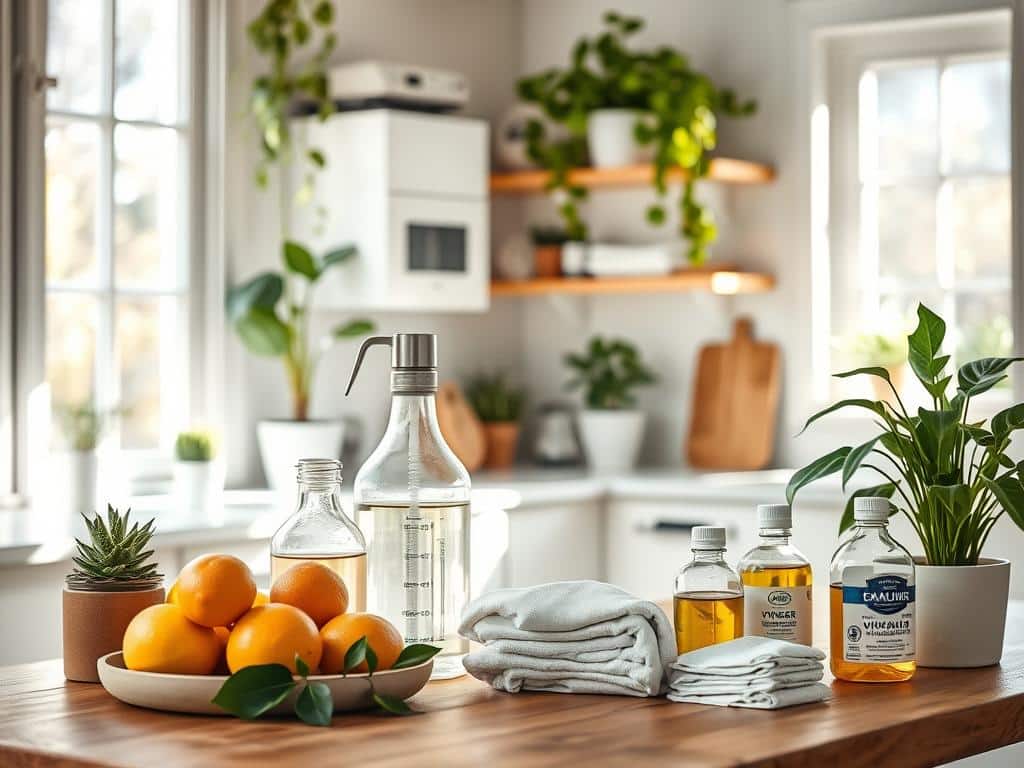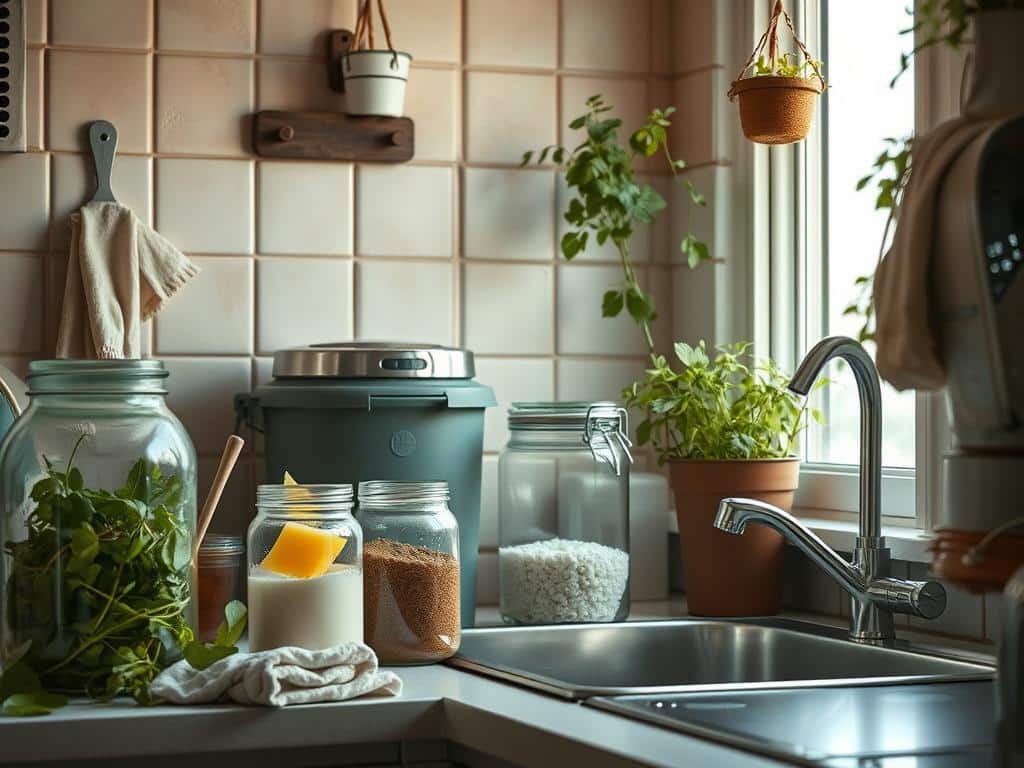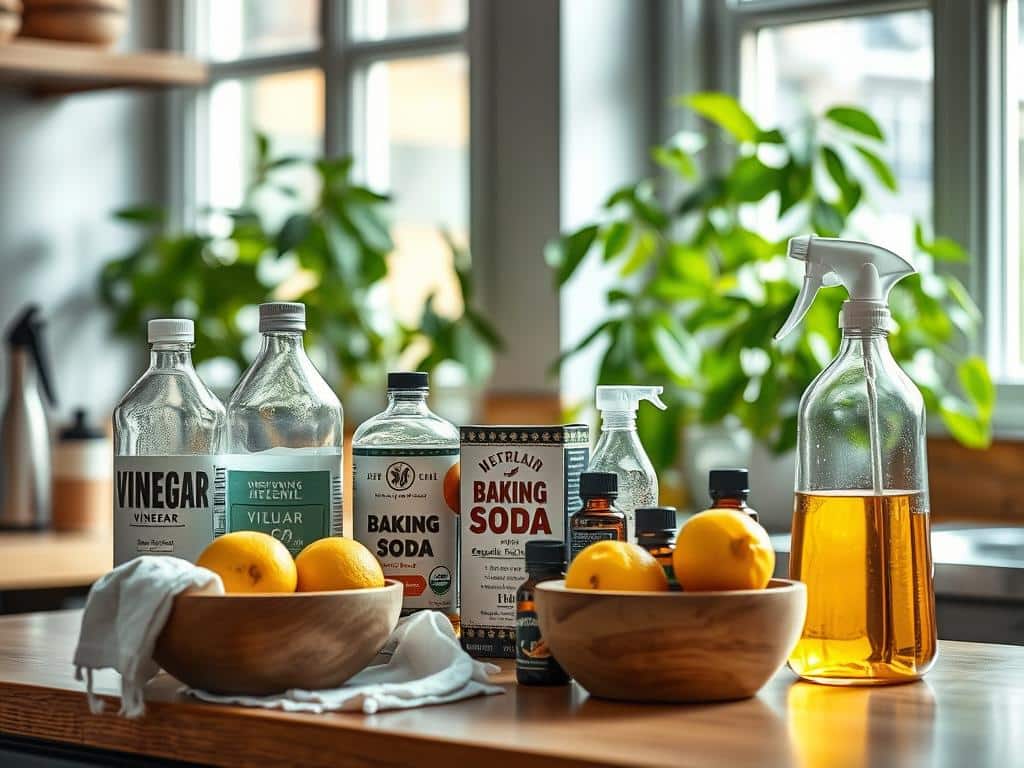
Switching to natural stain removers is good for the earth and cuts down your home’s harsh chemical use. Using eco-friendly stain solutions like baking soda, lemon or lime juice, and distilled white vinegar helps you fight laundry stains well and cheaply. These solutions are low-cost and support green cleaning ideals, leading to a healthier life.
A simple DIY natural stain remover mix includes one part Dr. Bronner’s Liquid Castile Soap, two parts Hydrogen Peroxide, and a drop of Citrus Fresh or Lemon Essential Oil. This combo is quick at getting rid of dirt stains. For tackling grass stains, a soft scrub can get you results in just five minutes.
Chemical-free stain removal options are more sought after nowadays. People want household stain remedies that are safe for both their family and the earth. Brands like Molly’s Suds are great at removing stains, even old ones. With these products, you don’t need harmful chemicals to keep your clothes clean.
The following sections will show you how to use these natural substances for great laundry outcomes. Keep reading to discover how baking soda, lemon juice, and distilled white vinegar can change your cleaning habits.
Baking Soda: A Versatile Laundry Aid
Baking soda is a top choice for eco-friendly laundry care. It tackles many laundry issues, from fighting odors to boosting detergent. Its low cost and high efficiency make it a must-have in homes.
How to Use Baking Soda for Stain Removal
Baking soda excels in removing stains with its natural power. Make a paste of baking soda and water to lift tough stains from clothes. For strong odors, soaking clothes in a baking soda solution before washing works well.
Spot cleaning with baking soda is easy for sweat, grass, and ink stains. It’s great for absorbing and cleaning.
Pro tip: Boost your detergent by adding baking soda directly to the washer. A half-cup per load freshens and softens your clothes.
Benefits for Fabrics and Laundry
Baking soda does more than just clean stains. It’s a powerhouse for removing odors and softening fabrics. It reacts with odor molecules, making clothes smell fresh without harsh chemicals.
It also keeps whites bright and colors vivid, extending your wardrobe’s life. Using baking soda is safe for kids’ clothes too. Avoid mixing it with vinegar in the wash, as this can reduce its effectiveness and harm your machine.
| Benefit | Description | Usage |
|---|---|---|
| Stain Removal | Effectively removes tough stains through absorbent properties | Create a paste with water |
| Odor Elimination | Neutralizes and eliminates odor molecules | Add a half-cup to laundry |
| Fabric Softening | Softens fabrics naturally, safe for all garments | Include in washer tub |
| Detergent Performance Booster | Enhances detergent efficiency, reducing suds in high-efficiency washers | Add directly to the washer |
Harness the Power of Lemon or Lime Juice
Lemon or lime juice adds flavor to dishes and naturally bleaches clothes. The acid in these fruits fights stains from rust and underarms. It’s eco-friendly, matching Squeaky Cleaner’s dry cleaning tips.
Removing Underarm and Rust Stains
Lemon or lime juice works alone or with other natural items for stains. Its acetic acid breaks down the mess:
- Underarm Stains: Put lemon juice on the spot. Wait 15 minutes, then rinse.
- Rust Stains: Mix lemon juice and salt. Apply, wait an hour, then wash off.
For tough stains, try a lemon half dipped in Borax powder. This mix cleans well and is safe for whites.
Making a Stain Removal Paste
You can make a natural paste with lemon juice, baking soda, and water. Here’s the method:
- Combine lemon juice and baking soda to get a thick paste.
- Put it on the stain and rub gently.
- Wait 30 minutes, then rinse it off.
This paste is great for rust and underarm stains.
Precautions for Colored Fabrics
Be careful with lemon and lime on colored cloth. These acids might change the color. Always test a small spot first.
Store any lemon and Borax mix in a sealed container in the fridge. Use gloves with Borax and keep it away from kids and pets.
Learn more about natural stain removers at Clotheslyne’s guide to lemon juice.
Using natural cleaning methods keeps clothes clean and your home healthy. It also cuts down on harsh chemicals.
Distilled White Vinegar: A Miracle Worker
Distilled white vinegar is a common item in most homes. It’s known for its eco-friendly benefits and versatility. It beats many store products as a natural stain lifter. This makes it budget-friendly and highly effective for laundry.

Using distilled white vinegar can change how you do laundry. Add a cup to the rinse cycle to brighten your clothes. It also removes yellow sweat marks and other hard-to-clean stains. The acid in vinegar tackles protein stains from sweat and food, leaving your clothes spotless.
Vinegar is more than a mildew stain fighter; it doubles as a natural fabric softener. Add half to one cup to your wash to neutralize smells, making your clothes smell fresh. This green alternative cuts down on static, pet hair, and lint in fabrics.
Vinegar also cleans and maintains your washing machine. A vinegar cycle keeps the appliance running well. It fights soap buildup and smells, creating a cleaner space for laundry.
For naturally brighter clothes, try vinegar with lemon juice. Mix half a cup of each with a tablespoon of borax for a powerful brightener. It brings back the color in your fabrics and fights soap residue.
Distilled white vinegar is cheaper than fabric softeners and bleach. It’s a smart pick for sustainable households. It keeps your laundry colorful and odor-free, all while being kind to the environment and your clothes.
| Benefit | Vinegar | Fabric Softener | Chlorine Bleach |
|---|---|---|---|
| Cost-Effective | Yes | No | No |
| Eco-Friendly | Yes | No | No |
| Anti-bacterial | Yes | No | No |
| Mildew Stain Remover | Yes | No | No |
| Neutralizes Odors | Yes | Yes | No |
| Softens Fabrics | Yes | Yes | No |
| Machine Cleaner | Yes | No | No |
| Laundry Brightener | Yes | No | Yes |
Hydrogen Peroxide as a Safer Bleach Alternative
Hydrogen peroxide is a better choice than chlorine bleach. It whitens clothes and gets rid of tough stains well. This product is made from hydrogen and oxygen. It’s become known as a safe way to make fabrics white.
Using Hydrogen Peroxide for Whitening
Want to make your whites whiter or remove stubborn stains? Just add one cup of hydrogen peroxide to your wash. For carpets, mix water and hydrogen peroxide equally. This mix is safe for removing stains. It’s perfect for homes that are always busy. Hydrogen peroxide is great for keeping your fabrics bright without using harsh chemicals.
Tackling Tough Stains on Whites and Lights
Hydrogen peroxide works well on hard stains, like underarm yellows. Apply it directly to blood stains for quick removal. A mix of hydrogen peroxide and dish soap removes wine and fruit juice stains effectively. Powerizer products have double the hydrogen peroxide found in regular bottles. This shows its strong cleaning abilities.
Knowing the benefits of hydrogen peroxide for fabrics is key. Below, you can compare bleach alternatives. They’re rated on effectiveness, how eco-friendly they are, and their toxicity levels:
| Criteria | Percentage |
|---|---|
| Natural Bleach Alternatives | 66.7% |
| Eco-Friendly Alternatives | 73.3% |
| Potentially Toxic Alternatives | 26.7% |
| Effectiveness on White Clothes | High |
| Suitability for Colored Clothes | Confirmed |
Using hydrogen peroxide in your laundry is safe and eco-friendly. Products like Powerizer offer effective, fabric-friendly solutions. This makes choosing non-toxic fabric whiteners even more attractive.
Effective Talcum Powder and Cornstarch Solutions
Talcum powder and cornstarch are great for greasy or oily stains on clothes. They are natural and absorb oils well. This can save your favorite garments from being ruined.
Absorbing Oily and Greasy Stains
Talcum powder and cornstarch are effective remedies for oil spills on fabric. Just apply the powder directly onto the stain and wait 15-20 minutes. It absorbs the oil well. Then, you can brush off the powder gently. This method works well for delicate fabrics and is quick for DIY laundry prep.
Application Techniques and Tips
Using talcum powder and cornstarch is safe and non-toxic. Here’s what to do:
- Sprinkle the powder over the stain immediately.
- Let it sit to absorb the oil for 15-20 minutes.
- Gently brush off any excess powder.
- Then wash the garment as usual.
Adding this method to your cleaning routine can make life easier. For more tips, check out Squeaky Cleaner Homes.
Using talcum powder and cornstarch keeps your clothes looking new. It avoids chemicals and is better for your home.
Natural Stain Removers: Rice Flour and Chalk
Rice flour and chalk are great at getting rid of tough stains. They soak up grease well and are kind to the environment. They also take care of fabrics gently.
Rice flour is good for treating grease, oil, and protein stains. It gets deep into fabrics to remove greasy spots. Just put rice flour on the stain, wait, then wash as you normally would. It’s gentle, so it won’t harm delicate materials.
Chalk is also good for oil and grease stains. Its ability to soak up oils helps clean your clothes. Just cover the stain with chalk, wait a bit, then wash. Chalk is safe and eco-friendly, making it a smart choice for removing stains.
The chart below showcases the effectiveness of these natural absorbents:
| Natural Absorbent | Best for Stains | Additional Benefits | Eco-Friendly |
|---|---|---|---|
| Rice Flour | Grease, Oil, Protein-based | Gentle on delicate fabrics | Yes |
| Chalk | Grease, Oil | Non-toxic, safe for most fabrics | Yes |
Using rice flour and chalk for laundry means choosing powerful, natural cleaners. They effectively handle grease stains while caring for both your clothes and the planet.
Conclusion
Using natural stain removers offers a safe, cheap, and green way to handle laundry problems. You can use items like baking soda, citrus juice, white vinegar, and hydrogen peroxide. Absorbent powders such as talcum, cornstarch, rice flour, and chalk also work well. These options help fight stains without harmful chemicals.
They protect your clothes and fabrics. This way, things like food spills, grease, ink, and even pet stains can be removed safely. Your items stay looking good.
Natural solutions have been tested for their effectiveness. For instance, a mix of vinegar and baking soda was rated 2.0 against blueberry syrup stains. But a store-bought pre-stain treatment got a 5 for ketchup stains. Though commercial products might work faster, natural methods are kinder to fabrics and the environment.
A pre-stain mix of vinegar, baking soda, and regular detergent scored 4.75 for removing mustard. This shows combining natural and commercial solutions can be very effective.
Choosing natural stain removers is good for your family and the Earth. These methods are easy to use but very effective. They decrease the need for harmful chemicals, making your home more eco-friendly. Next time you’re dealing with a tough stain, remember the power of nature. You can keep your laundry clean and support a healthier planet.



